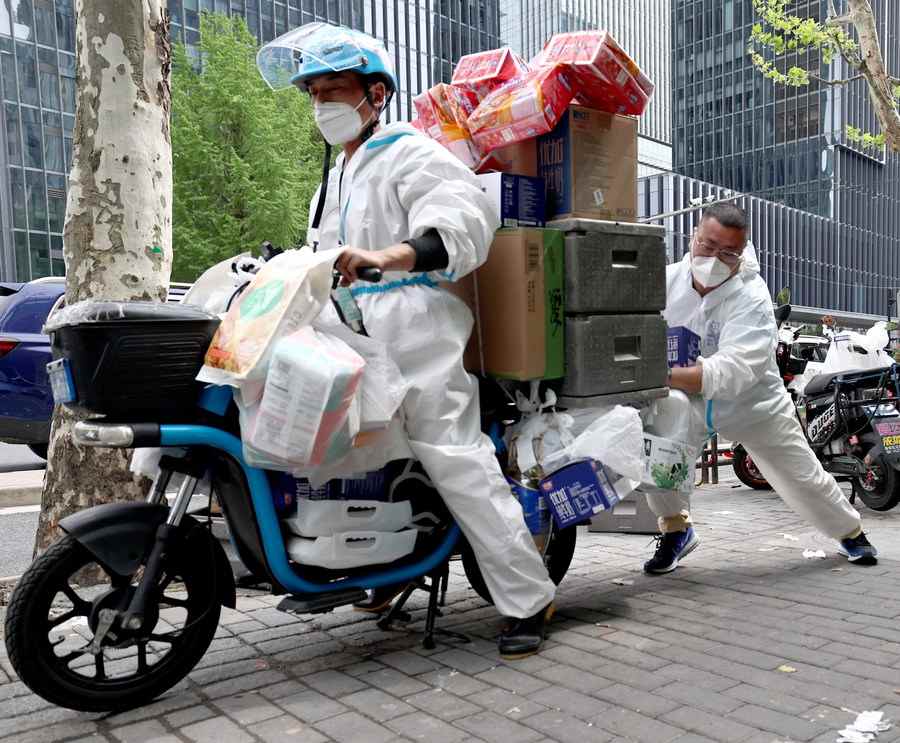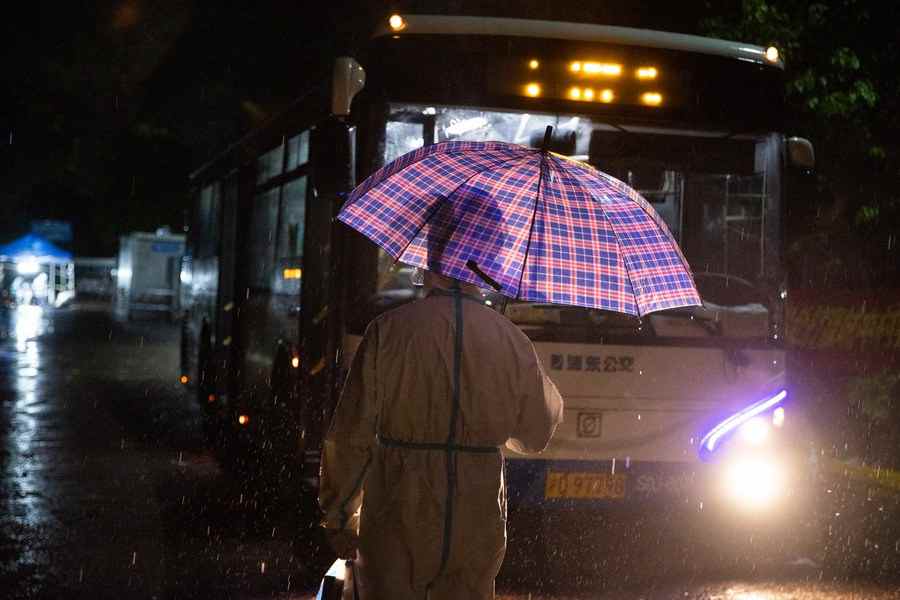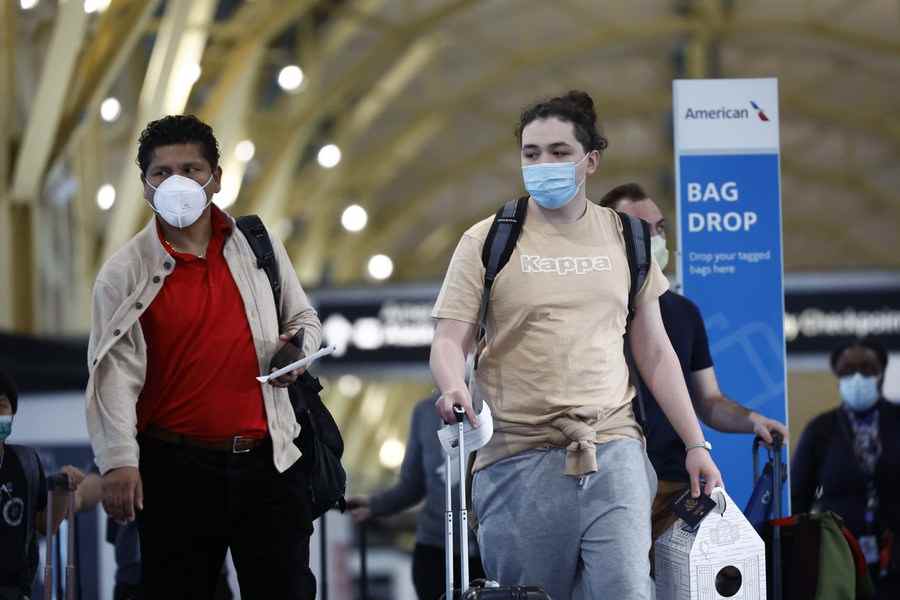NYT's biased report on Shanghai's COVID fight betrays its ignorance of China

Staff members prepare to conduct nucleic acid test for citizens in Huangpu District, east China's Shanghai, April 26, 2022. (Xinhua/Li He)
Perhaps that is because of U.S. media's die-hard habit of smearing China in every possible way.
BEIJING, May 1 (Xinhua) -- Once again, The New York Times (NYT) betrayed its ignorance of China.
In a recent report on the COVID-19 fight in Shanghai, the American newspaper jumped to a conclusion that the legitimacy of the Communist Party of China (CPC) is being tested, because residents in Shanghai are volunteering to help each other out during "lockdown" in recent weeks. Such an argument is as ridiculous as it is malicious.
In a stunningly far-fetched manner, the article tried to equate natural and warm-hearted mutual assistance with some kind of expression of discontent towards the CPC. Apparently, its authors were hardly touched by the love and care expressed by ordinary Chinese towards one another in their hours of difficulties. Perhaps that is because of U.S. media's die-hard habit of smearing China in every possible way.
Indeed, Shanghai has been experiencing its most severe COVID-19 wave in the past two years. Its residents' life and work have been impacted by strict measures to contain the highly contagious Omicron variant. And at the early stage of the outbreak, some people encountered various kinds of inconveniences to get food supply and medical treatments.

Du Shun (R), deputy manager of a Hema Fresh store in Wuhan, helps Liu Zengyu, a delivery man from Jiangxi Province, start his electric bicycle to deliver goods in Shanghai, east China, April 15, 2022. (Xinhua/Chen Jianli)
After all, meeting the daily needs of more than 25 million residents in China's biggest city in highly restricted conditions with no precedent to follow has posed a strenuous challenge. That is why the local authorities have on many occasions acknowledged their problems, and vowed repeatedly to improve their services.
And instead of hurting the CPC's legitimacy, the fact that hundreds of thousands of local citizens volunteer to lend each other help and support testifies to the strength of the Party.
In fact, many of the volunteers are either organized by the local authorities or working closely with neighborhood committees. And among those tens of thousands of volunteers the NYT mentioned, a large portion of them are CPC members.
"Wherever there is a need, there must be a Party member," the CPC Shanghai Municipal Committee said in a recent open letter to CPC members in Shanghai. "Our Party members must go deep into the community and the masses, stand by and work with cadres and the people in the front line."

A volunteer waits for COVID-19 close contacts to board a transfer bus in Lianqin Village of Beicai Town, east China's Shanghai, April 28, 2022.(Xinhua/Jin Liwang)
Official statistics show that more than 700,000 Party members in Shanghai have registered to join the city's anti-COVID fight, and a large number of CPC members have been working as volunteers in districts, towns and villages. In some communities, 90 percent of community volunteers are Party members.
Anyone with some basic knowledge of the CPC's history would know that mobilizing the public to work with the Party in joint efforts to tide through hard times is both a tradition and a strength of the CPC, as the CPC has pledged that "everything is for the people and everything relies on the people."
Today, there are more than 95 million Party members from all walks of life across China. They are both members of the big Chinese family and representatives of their fellow countrymen. According to a report by Harvard University, the Chinese people's overall satisfaction toward the central government has been above 90 percent for years. Any attempt to sow discord between the Chinese people and the CPC would be futile. The NYT's attack on China's dynamic zero-COVID policy would be no different.
At the moment, the dynamic zero-COVID approach to containing the virus remains the most optimal choice for China.
"If we are not firm about the dynamic zero-COVID policy, China may miss the best time to stem the resurgence of cases, which may lead to higher costs and unbearable consequences," said China's leading epidemiologist Liang Wannian.
As China's economic center and an important link of the global supply chains, Shanghai can only minimize the impact of the pandemic on China and the global economy by putting the resurgence of COVID-19 cases under control and returning to normal as soon as possible. It is the broadest consensus shared by the general public in China.
And from a global perspective, by strictly enforcing the dynamic zero-COVID policy, China is making a huge sacrifice to ensure the long-term economic viability of Shanghai in global trade and commerce, which would inject more certainty into the world economy.

Travelers walk through terminals at Ronald Reagan Washington National Airport in Arlington, Virginia, the United States, April 14, 2022. (Photo by Ting Shen/Xinhua)
What also should be noted is that by citing people's self-reliance as evidence of public frustration, the NYT actually exposed America's monumental failure in battling the pandemic. Over the past more than two years, Washington has largely failed to shoulder its responsibility in leading the anti-COVID-19 fight, and left the American people to fend for themselves.
The NYT should quit its biased coverage on China, and try to understand the country and its ruling party better.
In 1936, when the prospect of the CPC-led social revolution was still unclear, Edgar Snow, an American journalist, ventured to north of China's Shaanxi Province, where the CPC and its military "the Red Army" were based and surrounded by resourceful and powerful enemies. Through comprehensive interviews and objective analysis, Snow made an accurate and foresighted judgment in his report that the social revolution "would eventually win."
In a cave dwelling on the Loess Plateau, Snow asked then 43-year-old Mao Zedong: the enemies' "economic resources many times surpassed ours, and they received material assistance from the outside. Why, then, has the Red Army scored success after success ... and not only survived still today but increased its power?"
"The explanation is that the Red Army and the (CPC-established) Soviet Government had created among all people within their areas a rocklike solidarity, because everyone ... was voluntarily and consciously fighting for his own interests and what he believed to be right," Mao replied.
Eighty-six years later, Snow's professionalism and Mao's words about the CPC's successes can still offer some clues about how the Western mainstream media, including the NYT, can tell their stories of China and the CPC.
Photos
Related Stories
- 3,447 COVID-19 patients discharged from hospitals on Chinese mainland
- Chinese mainland reports 916 new local COVID-19 cases
- Beijing building makeshift hospitals
- HKSAR gov't continues to provide free COVID-19 testing service for elderly, targeted groups
- China's food giant enhances supply to Beijing amid COVID-19 resurgence
- HKSAR gov't continues to provide free COVID-19 testing service for elderly, targeted groups
- Shanghai group buying organizers fill niches, warm hearts
- Shanghai's new COVID-19 cases all from closed-off management area
- Beijing ups restrictions to contain latest COVID-19 flare-ups
- Shanghai reports 788 confirmed, 7,084 asymptomatic local COVID-19 cases
Copyright © 2022 People's Daily Online. All Rights Reserved.










